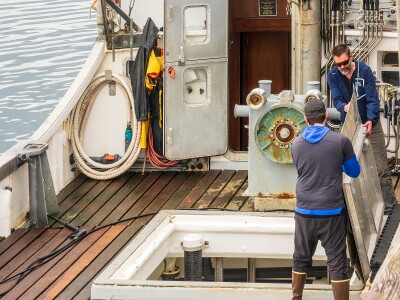Cutting your losses
Based on U.S. Coast Guard reports.
We all know how important it is to run drills and practice emergency procedures. And your inclination may be to stay with your boat unless and until it's going down. However, sometimes knowing when to give up is the tipping point of survival at sea. In the case of a vessel fire, do you know your limits?
A 70-foot wooden-hulled shrimper built in the late 1960s was fishing with a three-man crew about three miles off of Myrtle Beach, S.C. It was a late October mid-afternoon, and the vessel was in rough seas. Perhaps as a result of the rough seas the exhaust stack cracked, and the heat ignited nearby wood, despite the lagging that had been installed.
The crew responded quickly and fought the fire. They thought they had put it out, but it reflashed. Within roughly 15 minutes, the fire was out of control. The skipper ordered the crew to don survival gear and abandon ship. Unfortunately, the fire engulfed the cabin, so the crew was unable to reach their survival suits and only had access to lifejackets.
Before abandoning the shrimp boat, the skipper managed to get back to the wheelhouse to send out a mayday call to the Coast Guard. He also retrieved the vessel's EPIRB. Another shrimp boat nearby responded to the mayday. One of the crew couldn't swim, so his fellow crew members threw him in the good Samaritan boat's life float. A Coast Guard helicopter hoisted him to safety. The other two men swam to the responding shrimp boat.
In another incident, a 50-foot salmon seiner with a crew of four was working in Resurrection Bay southeast of Seward, Alaska. The vessel was built in 1988 and had a fiberglass hull. It was about 3 a.m. on a mid-July morning and the vessel was steaming back to port to off-load, when a fire broke out in the engine room. Weather and sea conditions were typical for the area and did not play a role in the incident.
The skipper was awakened by the crewman on watch. He reported heavy smoke coming from the engine room. As the skipper was going to check the situation, he noticed the engine felt and sounded like it was running rough, and he saw heavy black smoke coming out of the engine room. He woke up the two other crewmen and told them to get their survival gear and come on deck. The skipper tried again to check the engine room, but the smoke was even heavier, and alarms were sounding.
With flames visible at that point, the skipper realized he and his crew had to abandon ship. He directed the crew to put on their survival suits and get into the seine skiff. The skipper then went to the bridge to send out a mayday call. He was able to make contact with the Coast Guard Air Station in Kodiak, but heavy smoke forced him out of the wheelhouse before he passed along much information.
When he returned to the skiff, a crew member asked about the hand-held VHF radio they had started using during their operations. The crew member was able to retrieve it from the wheelhouse and return to the skiff before they cast off from the burning vessel. The skipper used the portable radio to re-establish contact with the air station crew. He was also able to contact a nearby vessel that was already headed toward the fire. The good Samaritan vessel picked up the crew and delivered them to Seward.
Lessons learned
These cases ended without injury because the crews of these fishing boats responded appropriately and quickly. They couldn't control the fires, and they knew when to abandon the vessels for safety. The skippers directed their crews to get their survival gear right away, were able to make mayday calls, and took a radio or EPIRB with them into the survival craft.
The exact causes of these fires could not be determined, but we can examine suspected reasons. In the first incident, the vessel's skipper believed the fire started around the exhaust stack. In the second incident, the fire likely started because a fuel line or pump that supplied the cabin and wheelhouse oil stoves ruptured or leaked, and the fuel reached an ignition source in the engine room.
Whenever possible, check the fuel lines and pumps for leaks and improperly secured connections before you get underway. How close are they to an ignition source? Can they be rerouted or protected in any way?
Stow lifesaving and survival gear where it is readily accessible. The fire prevented the crew in the first incident from reaching some of their gear. Fortunately, they had vests stowed in another locker. Where you store your gear or how much gear you store, particularly on a smaller vessel, could determine your chances of survival in some remote locations or under adverse weather conditions.
When a fire occurs, early determination of your ability to control it and taking the appropriate measures from that point will help ensure your survival and rescue. So, make sure your vessel is safe to go fishing, be prepared for emergencies at sea, and come back home for another trip.






